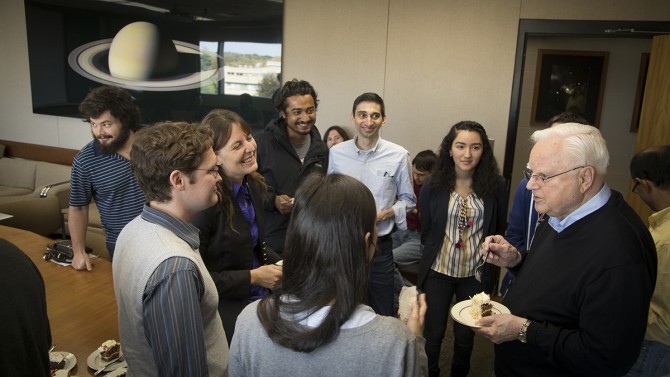Pioneer in the search for ET looks back, ahead in talk
By Linda B. Glaser
Frank Drake ’51 has been searching for evidence of intelligent life in the universe for 57 years. In an astronomy colloquium talk Oct. 19, “New Frontiers in the Search for Extraterrestrial Intelligence,” Drake described the search efforts made so far and new opportunities provided by recent technological – and philanthropic – advances.
As Cornell’s director of the Arecibo Observatory in Puerto Rico, Drake sent the first directed message to extraterrestrials into space, using radio waves, in 1974. He is also the creator of the Drake Equation, which estimates the number of active, communicative extraterrestrial civilizations in the Milky Way galaxy.
But the search for life beyond Earth is not only a modern effort. In the 1800s, radio inventor Guglielmo Marconi searched for radio signals from space. His effort was in vain, Drake explained, because Marconi was using a radio frequency that can’t penetrate Earth’s atmosphere.
The modern scientific search began in 1950, but it has gone slowly, with only limited government or philanthropic support. Two recent developments have fundamentally changed the picture, according to Drake.
A decrease in government support for radio telescopes has had the positive side effect – for the search – of freeing up considerable observing time on those telescopes. Because the Search for Extraterrestrial Intelligence (SETI) that Drake has spearheaded requires a great deal of observing time, this has been a boon to the project.
Philanthropist Yuri Milner’s decision to support SETI with $10 million a year has also been a game-changer, said Drake. And the recent discovery that almost all stars have planetary systems means that “there are many more opportunities for life than we assumed in the past.”
But which telescope is used makes a difference. Drake pointed out that the Allen Telescope Array, with 42 antennas, at the Hat Creek Radio Observatory in California, where much of the recent SETI research has been done, can see about 65 stars at once. Those stars are likely to have about 13 planets in the habitable zone (the habitable zone is the distance from the sun at which a rocky planet could support liquid water on its surface). In contrast, the Arecibo radio telescope’s beam can take in 14,000 stars, with an estimated 2,800 planets likely to be in the habitable zone. “We’ve come to know far better how to optimize our searches and where to look,” said Drake, noting the efforts of Cornell’s Carl Sagan Institute in the search for exoplanets and life.
Back when SETI began, lasers were too weak to transmit even to the nearest star, so the search concentrated on detecting radio waves. “The development of super powerful lasers has changed all that,” said Drake. Lasers developed for nuclear fusion purposes can outshine star light by 3,000 times, and even though the beam lasts only for a nanosecond, it is still easier to detect such a signal than a radio wave. And because they are so definitively of intelligent origin, there are fewer problems with the interference and false positives that plague radio searches. Radio interference has only increased as the number of spacecraft orbiting Earth has increased.
“We’re now looking for artificial pulsed laser emissions in our galaxy,” said Drake. “We suspect that there are brief signals because we detect brief pulses, but they don’t repeat. They could, in fact, be other civilizations sending us brief signals with information coded on them we can’t detect. Or maybe they’re sending a signal from one star to another, but only once in our direction, so we can only detect them once, and we can't be sure the signal was of intelligent origin.”
When asked during the Q&A why there has been nothing conclusively detected after 57 years of searching, Drake said “we’ve been looking at one star at a time for 10 minutes. That’s just a drop in the bucket … if signals are only there for a fraction of a second, we haven’t looked long enough at enough stars to see them.”
The solution, said Drake, is the proposed Pulsed All-Sky Near-Infrared Optical SETI (PANOramic SETI). It is designed to look at all the sky all the time, as Earth rotates. “We have a design and a prototype, and we have a detector that fits the bill,” said Drake. “On-site tests will be performed soon. We’re coming to a new era in SETI when there won’t be problems of false positives.”
Linda B. Glaser is a staff writer for the College of Arts and Sciences.
Media Contact
Get Cornell news delivered right to your inbox.
Subscribe